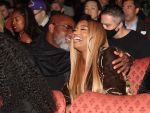Inside the smaller theater at Madison Square Garden about five years ago, shortly before a world title fight, Emile Griffith was introduced one more time to the crowd. He rose shakily from his seat, waved ever so briefly and then sat down.
The applause kept going.
Revered in retirement perhaps more than during his fighting days, Griffith died Tuesday at 75 after a long battle with pugilistic dementia. The first fighter to be crowned world champion from the U.S. Virgin Islands, Griffith required full-time care late in life and died at an extended care facility in Hempstead, N.Y.
“Emile was a gifted athlete and truly a great boxer,” Hall of Fame director Ed Brophy said. “Outside the ring he was as great a gentleman as he was a fighter.”
An elegant fighter with a quick jab, Griffith’s brilliant career was overshadowed by the fatal beating he gave Benny “The Kid” Paret in a 1962 title bout. The outcome darkened the world of boxing, even prompting some network television stations to stop showing live fights.
It also cast him as a pariah to many inside and outside the sport.
He went on to have a successful career after that fatal fight, but Griffith acknowledged later in life that he was never the same boxer. He would fight merely to win, piling up the kind of decisions that are praised by purists but usually jeered by fans hoping for a knockout.
Griffith often attended fights in his later years, especially at the Garden, where he headlined 23 times. He was also a frequent visitor to the boxing clubs around New York City, and made the pilgrimage most years to the sport’s Hall of Fame in Canastota, N.Y.
“He always had time for boxing fans when visiting the hall on an annual basis,” Brophy said, “and was one of the most popular boxers to return year after year.”
That outpouring of love that he received late in life stood in stark contrast to the way he was received after March 24, 1962, when he fought Paret before a national TV audience at the Garden. Griffith knocked out his bitter rival in the 12th round to regain his own welterweight title, and Paret went into a coma and died from his injuries 10 days later.
Sports Illustrated reported in 2005 that Griffith may have been fueled by an anti-gay slur directed at him by Paret during the weigh-in. Over the years, in books and interviews, Griffith described himself at various times as straight, gay and bisexual.
“People spit at me in the street,” Griffith told The Associated Press in 1993, recalling the days after Paret’s death. “We stayed in a hotel. Every time there was a knock on the door, I would run into the next room. I was so scared.”
The Paret fight left a cloud over the sport for many years. NBC halted its live boxing broadcasts, and then-New York Gov. Nelson Rockefeller created a commission to investigate the bout and the sport. The referee that night, Ruby Goldstein, never worked another fight.
The fight became the basis for the 2005 documentary “Ring of Fire: The Emile Griffith Story.” One of the final scenes shows Griffith embracing Paret’s son.
“I was never the same fighter after that. After that fight, I did enough to win. I would use my jab all the time. I never wanted to hurt the other guy,” Griffith said. “I would have quit, but I didn’t know how to do anything else but fight.”
And fight he could.
Known for his overwhelming speed and slick style — certainly not his punching power — Griffith was a prodigy from the moment he stepped in Hall of Fame trainer Gil Clancy’s gym in Queens. Griffith had been working in a hat factory when, as the story goes, he took off his shirt on a hot day and the factory owner realized noticed his muscles.
Under the watchful eye of Clancy, Griffith blossomed into a New York Golden Gloves champion and eventually turned professional. He easily defeated the likes of Florentino Fernandez and Luis Rodriguez during an era when it was common to fight every couple of weeks.
He quickly earned a title shot against Paret in 1961, winning the welterweight belt with a knockout in the 13th round. Griffith would lose it to Paret in a rematch five months later.
After winning back the title during their controversial third fight — many believe Paret never should have been allowed in the ring after a brutal loss to Gene Fullmer three months earlier — Griffith would eventually move up to middleweight. He knocked down Dick Tiger for the first time in his career and claimed the title with a narrow but unanimous decision.
Griffith would go on to lose twice during a thrilling trilogy with Nino Benvenuti, his lone victory coming at Shea Stadium in 1967, and lost two bouts against the great middleweight Carlos Monzon. Griffith would finally retire in 1977 after losing his last three fights.
He was inducted into the Hall of Fame in 1990 with a record of 85-24-2 and 23 knockouts.
Griffith would go on to train several champions over the years, including Wilfred Benitez and Juan Laporte, among the most popular boxers in Puerto Rican history.
His humor and generosity buoyed those close to him as his health deteriorated in later years. He would regale fans young and old with tales of his fights, even though details often became hazy, the result of the many blows during his career.
Griffith had four sisters — Eleanor, Gloria, Karen and Joyce — and three brothers — Franklin, Guillermo and Tony. He is also survived by his adopted son, Luis Griffith.
Funeral arrangements are pending.
(Photo: AP)















